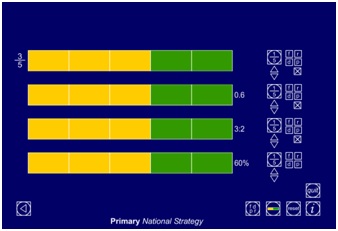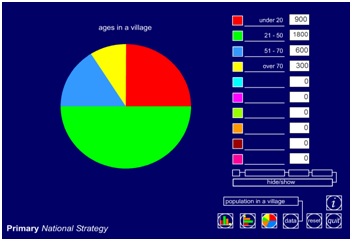Pupils should make rich connections across mathematical ideas to develop fluency, mathematical reasoning and competence in solving increasingly sophisticated problems. They should also apply their mathematical knowledge to science and other subjects.
– National Curriculum, September 2013, page 10)
Connections within Mathematics
Making connections to other topics within this year group
Number – Fractions
- use common factors to simplify fractions; use common multiples to express fractions in the same denomination
- associate a fraction with division and calculate decimal fraction equivalents (e.g. 0.375) for a simple fraction (e.g. ⅜)
- recall and use equivalences between simple fractions, decimals and percentages, including in different contexts
When working on ratio and proportion and/or fractions, including decimals and percentages, there are opportunities to make connections between them, for example:
In the same way that fractions describe the relationship between parts of a whole and the whole of which they are a part, proportion also expresses the relationship between parts and wholes. Ratio, on the other hand, describes the relationships between parts. When working with ratio, the whole can be inferred by understanding the total number of parts. In turn, once the total number of parts is known, any number of those parts can be expressed as a fraction or proportion of the whole. It is helpful to work through an example: imagine 10 counters of which 4 are red and 6 are blue. When comparing the red with the blue, we see that there are 4 red for every 6 blue; the ratio is 4:6. This can be simplified to 2:3. Proportion is usually represented as a fraction. Four out of ten counters are red, so, 4/10 are red. Six out of ten counters are blue, so, 6/10 are blue. These fractions can be simplified to ⅖ and ⅗. You can practise this with the children using counters, interlocking links or cubes or a collection of classroom items, for example, 8 pencils and 4 rubbers. 8⁄12of the collection are pencils, this fraction can be simplified to ⅔. 4⁄12 are rubbers, this can be simplified to ⅓. Simplifying fractions covers the first objective in the above list.
The fractions made can also be converted to decimals and percentages, for example 0.4 or 40% of the counters are red and 0.6 or 60% of the counters are blue. 0.3 of 30% of the collection are pencils and 0.7 or 70% are rubbers.
Using the ITP Fractions gives opportunities to visually make comparisons between fractions, decimals, ratio and proportion.

Ratio and proportion is another ITP worth exploring with the children. In this ITP you can demonstrate comparisons between different ratios and proportions with volumes of liquids.
Number-Multiplication and division
When working on ratio and proportion and/or multiplication and division there are opportunities to make connections between them, for example:
Scaling an object or an amount down by multiplying by a fraction, for example, if sketching a tree or building in the school’s grounds, the height would need to be scaled down. You could ask the children to make an estimate of the height of the object by walking away from it until, when they bend down they can see its top from between their legs. They put a marker at this point and then measure from the marker to the base of the object. This will give a reasonable estimate of its height because the child will be looking at the top of the tree at an angle of approximately 45 degrees if viewed in this way. Therefore, the height of the tree will be the same as the distance from it. To make a sketch, this measurement needs to be scaled down. For example if it was 10m tall and they wanted to make a scale drawing showing the tree as 1m high, they would need to draw the tree at a scale of 1:10 (or multiply the height of the tree by a scale factor of 1/10).
Children could draw classroom objects to scale. For example, the height of a table measuring 50cm could be scaled down to (multiplied by scale factor) 1/5 to make the table10cm in the drawing.
Statistics
- interpret and construct pie charts and line graphs and use these to solve problems
When working on ratio and proportion and/or statistics there are opportunities to make connections between them, for example:
Using the ITP Data Handling is an effective way to explore comparisons using a pie chart. In the example below, the children could estimate the percentages of people of different ages and compare them. They could present the information as proportions using fraction and/or decimals. They could compare data as ratios, for example the ratio of those under 20 to those between 20 and 50 is 1:2.

Making connections to this topic in adjacent year groups
Year 5
Number-Fractions (including decimals and percentages)
- read and write decimal numbers as fractions [for example, 0.71 = 71⁄100 ]
Non statutory guidance
- Pupils should be taught throughout that percentages, decimals and fractions are different ways of expressing proportions.
Key Stage 3
Number
- interpret fractions and percentages as operators
Ratio, proportion and rates of change
- use scale factors, scale diagrams and maps
- express one quantity as a fraction of another, where the fraction is less than 1 and greater than 1
- use ratio notation, including reduction to simplest form
- divide a given quantity into two parts in a given part:part or part:whole ratio; express the division of a quantity into two parts as a ratio
- understand that a multiplicative relationship between two quantities can be expressed as a ratio or a fraction
Cross-curricular and real life connections
Learners will encounter ratio and proportion:
Within the science curriculum there are opportunities to work with ratio and proportion. For example pupils should select the most appropriate ways to answer science questions using different types of scientific enquiry, including observing changes over different periods of time, noticing patterns, grouping and classifying things, carrying out comparative and fair tests and finding things out using a wide range of secondary sources of information. The children could, for example, construct pie charts or use ratio and proportion to compare groupings and classifications or the results of tests that they carry out.
Within the geography curriculum there are opportunities to connect with ratio and proportion, for example in the introduction of the Key Stage 2 Programme of Study it states that pupils should extend their knowledge and understanding beyond the local area to include the United Kingdom and Europe, North and South America. This will include the location and characteristics of a range of the world’s most significant human and physical features. Children could, for example, find and compare distances between countries or cities, compare population statistics, temperatures, lengths of rivers, heights of mountains. The results of any comparisons could be displayed in a pie chart.
There are also opportunities to work with ratio and proportion, linked to history, for example, ‘pupils should continue to develop a chronologically secure knowledge and understanding of British, local and world history, establishing clear narratives within and across the periods they study. The children could, for example, represent the lengths of the different periods in history and the rules of different British monarchs using pie charts’ (History Programme of Study). This would enable them to make comparisons using proportion as fractions or percentages.




